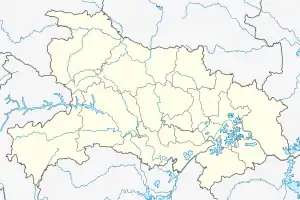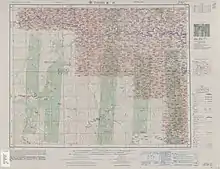Zhuxi County
竹溪县 Chuki | |
|---|---|
 Zhuxi Location of the seat in Hubei | |
| Coordinates: 32°19′06″N 109°42′55″E / 32.3183°N 109.7153°E | |
| Country | People's Republic of China |
| Province | Hubei |
| Prefecture-level city | Shiyan |
| Area | |
| • Total | 3,299 km2 (1,274 sq mi) |
| Population (2010)[1] | |
| • Total | 315,259 |
| • Density | 96/km2 (250/sq mi) |
| Time zone | UTC+8 (China Standard) |
| Website | www |
Zhuxi County (simplified Chinese: 竹溪县; traditional Chinese: 竹谿縣; pinyin: Zhúxī Xiàn) is a county in the northwest of Hubei province, People's Republic of China, bordering Shaanxi to the west and Chongqing to the southwest. It is under the administration of the prefecture-level city of Shiyan. The county spans an area of 3,279 km2 (1,266 sq mi),[2] and has a population of 315,259 as of 2010.[1]
Toponymy
The name Zhuxi County is named for the Zhuxi River, whose name (Chinese: 竹溪河; pinyin: Zhúxī Hé; lit. 'bamboo stream river') was derived from the large amounts of bamboo forests which bordered both sides of the river.[1]
History
The area of present-day Zhuxi County once belong to the Chu State.[1] Part of the remains of the Great Wall of Chu, which possibly date back to the 3rd century BCE.[2]
Zhuxi County was established in 1476 under the reign of the Chenghua Emperor.[1]
In 1914, it was placed under the jurisdiction of Xiangyang Circuit.[1] In 1932, the Republic of China introduced Administrative Inspectorates, and the county was assigned to the 11th Administrative Inspectorate of Hubei Province.[1] In 1936, it was re-assigned to the 8th Administrative Inspectorate of Hubei Province.[1]
In 1949, under the People's Republic of China, Zhuxi County was assigned to Liangyun Prefecture, which was renamed to Yunyang Prefecture the following year.[1]
The county was moved to Xiangyang Prefecture in 1952, but was moved back to Yunyang Prefecture in 1965.[1]
In 1994, Zhuxi County was placed under the prefecture-level city of Shiyan, where it remains today.[1]
In 2010, Longba was upgraded from a township to a town.[1] In 2013, Bingying and Huiwan were upgraded from townships to towns.[1]
Geography
The county's geography is fairly mountainous, with its highest point reaching approximately 2,740 metres (8,990 ft) in height.[2] The county's main rivers are the Zhuxi River and the Huiwan River, which both flow into the larger Han River.[2]
Climate
Zhuxi County experiences an average annual temperature of 14 °C (57 °F), and an average annual precipitation of 1,000 millimetres (39 in).[2]
| Climate data for Zhuxi (1991–2020 normals, extremes 1981–2010) | |||||||||||||
|---|---|---|---|---|---|---|---|---|---|---|---|---|---|
| Month | Jan | Feb | Mar | Apr | May | Jun | Jul | Aug | Sep | Oct | Nov | Dec | Year |
| Record high °C (°F) | 18.5 (65.3) |
24.0 (75.2) |
31.6 (88.9) |
34.5 (94.1) |
36.7 (98.1) |
38.3 (100.9) |
39.4 (102.9) |
38.5 (101.3) |
38.6 (101.5) |
31.6 (88.9) |
26.0 (78.8) |
19.4 (66.9) |
39.4 (102.9) |
| Mean daily maximum °C (°F) | 7.9 (46.2) |
11.1 (52.0) |
16.3 (61.3) |
22.5 (72.5) |
26.1 (79.0) |
29.5 (85.1) |
31.6 (88.9) |
30.6 (87.1) |
25.7 (78.3) |
20.4 (68.7) |
14.8 (58.6) |
9.4 (48.9) |
20.5 (68.9) |
| Daily mean °C (°F) | 2.2 (36.0) |
4.9 (40.8) |
9.4 (48.9) |
15.2 (59.4) |
19.5 (67.1) |
23.4 (74.1) |
25.8 (78.4) |
24.8 (76.6) |
20.3 (68.5) |
15.0 (59.0) |
9.0 (48.2) |
3.7 (38.7) |
14.4 (58.0) |
| Mean daily minimum °C (°F) | −1.4 (29.5) |
0.8 (33.4) |
4.6 (40.3) |
10.0 (50.0) |
14.6 (58.3) |
19.0 (66.2) |
21.9 (71.4) |
21.1 (70.0) |
16.9 (62.4) |
11.7 (53.1) |
5.4 (41.7) |
0.2 (32.4) |
10.4 (50.7) |
| Record low °C (°F) | −12.4 (9.7) |
−7.3 (18.9) |
−4.9 (23.2) |
−0.3 (31.5) |
5.3 (41.5) |
11.5 (52.7) |
12.6 (54.7) |
14.0 (57.2) |
7.3 (45.1) |
0.3 (32.5) |
−3.9 (25.0) |
−18.7 (−1.7) |
−18.7 (−1.7) |
| Average precipitation mm (inches) | 11.2 (0.44) |
17.4 (0.69) |
45.2 (1.78) |
70.1 (2.76) |
105.2 (4.14) |
134.5 (5.30) |
153.2 (6.03) |
145.7 (5.74) |
117.7 (4.63) |
88.6 (3.49) |
34.6 (1.36) |
12.4 (0.49) |
935.8 (36.85) |
| Average precipitation days (≥ 0.1 mm) | 6.6 | 7.2 | 10.5 | 10.6 | 12.8 | 12.3 | 13.3 | 12.8 | 13.1 | 12.0 | 8.7 | 6.8 | 126.7 |
| Average snowy days | 4.7 | 3.6 | 1.2 | 0 | 0 | 0 | 0 | 0 | 0 | 0 | 0.9 | 2.4 | 12.8 |
| Average relative humidity (%) | 81 | 78 | 77 | 77 | 78 | 79 | 83 | 84 | 85 | 86 | 85 | 83 | 81 |
| Mean monthly sunshine hours | 103.8 | 101.4 | 138.3 | 161.0 | 167.7 | 176.2 | 194.4 | 180.8 | 120.8 | 105.9 | 102.9 | 102.2 | 1,655.4 |
| Percent possible sunshine | 32 | 32 | 37 | 41 | 39 | 41 | 45 | 44 | 33 | 30 | 33 | 33 | 37 |
| Source: China Meteorological Administration[3][4] | |||||||||||||
Administrative divisions

Zhuxi County is divided into eleven towns, four townships, and eight other township-level divisions.[5]
Its eleven towns are Chengguan, Jiangjiayan, Zhongfeng, Shuiping, Xianhe, Quanxi, Fengxi, Longba, Bingying, Huiwan, and Xinzhou.[5]
Its four townships are Eping Township, Tianbao Township, Taoyuan Township, and Xiangba Township.[5]
Its other township level divisions are Longwaya Tea Farm (Chinese: 龙王垭茶场), Guoying Zhuxi Comprehensive Farm (Chinese: 国营竹溪综合农场), Stock Seed Farm (Chinese: 原种场), Fishing Stock Farm (Chinese: 渔种场), Zhongxu Field (Chinese: 种畜场), Wangjiashan Tea Farm (Chinese: 王家山茶场), Biaohu Tree Farm (Chinese: 标湖林场), and Shuangzhu Tree Farm (Chinese: 双竹林场).[5]
Economy
Zhuxi County has sizable deposits of coal, limestone, and marble.[2] The county is also home to the most Taxus chinensis production of a county in China.[2]
References
- 1 2 3 4 5 6 7 8 9 10 11 12 13 14 竹溪县历史沿革 [Zhuxi County Historical Development]. 行政区划网 [www.xzqh.org] (in Simplified Chinese). 2014-08-01. Archived from the original on 2020-12-31. Retrieved 2020-12-30.
- 1 2 3 4 5 6 7 竹溪县概况地图 [Zhuxi County Overview]. 行政区划网 [www.xzqh.org] (in Chinese). 2014-08-01. Archived from the original on 2020-12-31. Retrieved 2020-12-30.
- ↑ 中国气象数据网 – WeatherBk Data (in Simplified Chinese). China Meteorological Administration. Retrieved 11 June 2023.
- ↑ 中国气象数据网 (in Simplified Chinese). China Meteorological Administration. Retrieved 28 May 2023.
- 1 2 3 4 2020年统计用区划代码 [2020 Statistical Area Numbers and Rural-Urban Area Numbers] (in Chinese). National Bureau of Statistics of China. 2020. Archived from the original on 2020-12-31. Retrieved 2020-12-30.